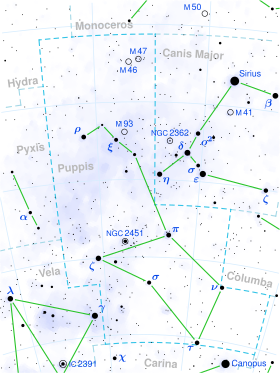| Observation data Epoch J2000 Equinox J2000 | |
|---|---|
| Constellation | Puppis [1] |
| Right ascension | 07h 40m 23.21044s [2] |
| Declination | −15° 15′ 50.1107″ [2] |
| Apparent magnitude (V) | 4.98 [1] |
| Characteristics | |
| Evolutionary stage | red giant branch [2] |
| Spectral type | K3II [3] |
| U−B color index | +1.79 [4] |
| B−V color index | +1.56 [4] |
| Astrometry | |
| Radial velocity (Rv) | +0.10 [5] km/s |
| Proper motion (μ) | RA: −2.171 [2] mas/yr Dec.: −27.678 [2] mas/yr |
| Parallax (π) | 4.915±0.1044 mas [2] |
| Distance | 660 ± 10 ly (203 ± 4 pc) |
| Absolute magnitude (MV) | −1.65 [1] |
| Details | |
| Mass | 1.9 [2] M☉ |
| Radius | 61 [2] R☉ |
| Luminosity | 1,267 [1] L☉ |
| Surface gravity (log g) | 0.99 [2] cgs |
| Temperature | 4,018 [6] K |
| Metallicity [Fe/H] | −0.13 [1] dex |
| Rotational velocity (v sin i) | < 2.2 [7] km/s |
| Age | 1.32 [2] Gyr |
| Other designations | |
| 140 Puppis, BD−14°2082, GC 10328, GSC 05980-01606, HIP 37379, HR 2959, HD 61772, SAO 153227 | |
| Database references | |
| SIMBAD | data |

HD 61772 is a bright giant star in the constellation Puppis. Its apparent magnitude is 4.98 and it is approximately 660 light years away based on parallax.
The apparent Flamsteed designation 140 Puppis is actually a shorthand of the Gould designation 140 G. Puppis, unambiguous in this case. [8]
The spectrum of HD 61772 match that of a K3II star, a cool bright giant. It has evolved away from the main sequence after about 1.3 billion years and is now 61 times the size of the Sun. Despite being cooler than the Sun at 4,018 K , it is over a thousand times more luminous. Evolutionary models place it near the tip of the red giant branch. [2]
